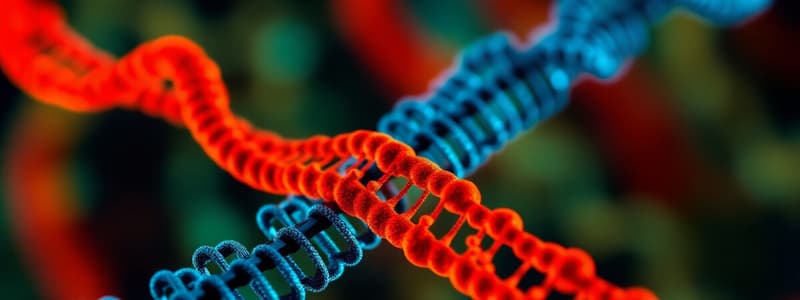Podcast
Questions and Answers
What is the primary goal of bioinformatics?
What is the primary goal of bioinformatics?
- To create new biological organisms
- To perform laboratory experiments
- To discover new drugs
- To interpret biological data (correct)
Less than 2% of the human genome encodes proteins.
Less than 2% of the human genome encodes proteins.
True (A)
What are transcriptomes?
What are transcriptomes?
The entire set of RNA molecules produced by a genome.
The _______ contains about 20,000 protein-coding genes.
The _______ contains about 20,000 protein-coding genes.
Match the following bioinformatics centers with their descriptions:
Match the following bioinformatics centers with their descriptions:
Which of the following techniques is NOT typically associated with bioinformatics?
Which of the following techniques is NOT typically associated with bioinformatics?
Bioinformatics is solely a branch of biology.
Bioinformatics is solely a branch of biology.
What are biological databases?
What are biological databases?
Which of the following fields does bioinformatics NOT integrate with?
Which of the following fields does bioinformatics NOT integrate with?
Bioinformatics is only used to analyze data from protein-coding genes.
Bioinformatics is only used to analyze data from protein-coding genes.
What percentage of the human genome encodes proteins?
What percentage of the human genome encodes proteins?
The _____ analyzes the entire set of RNA molecules produced by a genome.
The _____ analyzes the entire set of RNA molecules produced by a genome.
Match the following bioinformatics centers with their main functions:
Match the following bioinformatics centers with their main functions:
Which of the following is a major component of bioinformatics?
Which of the following is a major component of bioinformatics?
Biological databases are unstructured and not searchable.
Biological databases are unstructured and not searchable.
In which decade did the collection and cataloguing of DNA sequence data begin?
In which decade did the collection and cataloguing of DNA sequence data begin?
Study Notes
Bioinformatics Explained
- The application of computational and analytical tools to interpret biological data.
- Combines computer science, biology, physics, chemistry, and statistics.
- Aims to solve biological problems, understand biological processes, and utilize information technology for biological solutions.
- Focuses on storing, retrieving, and analyzing massive biological information.
Bioinformatics: An Interdisciplinary Field
- Involves diverse areas like science, medicine, and future technologies.
- Essential for analyzing "big data" derived from biological sources.
Human Genome Analysis
- Contains approximately 20,000 protein-coding genes.
- Surprisingly, only 2% of the human genome codes for proteins.
- The remaining 98% consists of regulatory elements and non-coding RNA genes.
Analyzing Large Data Sets
- Bioinformatics techniques are designed to identify:
- Transcriptomes: Complete sets of RNA molecules produced by a genome, revealing gene expression patterns.
- Proteomes: The structures and properties of all proteins produced by a genome.
Bioinformatics Centers of Excellence
- Global presence, responsible for collecting, cataloguing, and providing open access to biological data.
- These centers originated in the early 1980s, as DNA sequence data accumulation grew.
Key Bioinformatics Centers
- The European Bioinformatics Institute (EMBL-EBI)
- The US National Center for Biotechnology Information (NCBI)
- The National Institute of Genetics in Japan (NIG)
- The Barcode of Life Data System (BOLD)
Biological Databases
- Organized collections of structured, searchable, regularly updated, and cross-referenced biological information.
NCBI: National Center for Biotechnology Information
- An international repository for biological data, known for its advancements in science.
What is Bioinformatics?
- Bioinformatics is the application of computing and analysis tools to interpret biological data.
- It is an interdisciplinary field that incorporates computer science, biology, physics, chemistry, and statistics.
- Its primary goal is to understand biological processes, solve biological problems, and find solutions using information technology.
- Bioinformatics deals with large amounts of biological information, making it a vital field for analyzing and interpreting data.
Bioinformatics: A Science of Big Data
- The human genome contains approximately 20,000 protein-coding genes.
- This is slightly more than a worm, around twice the number of a fruit fly, and 12,000 less than a rice plant.
- Less than 2% of the human genome actually encodes proteins.
- The remaining 98% contains crucial regulatory elements and genes that encode non-coding RNA products.
Bioinformatics Techniques for Analyzing Big Data
- Bioinformatics techniques are designed to identify and analyze:
- Transcriptomes: The complete set of RNA molecules produced by a genome, revealing gene expression.
- Proteomes: The structure and properties of every protein produced by a genome.
Bioinformatics Centers of Excellence
- Centers of excellence for bioinformatics are found worldwide.
- They are responsible for collecting, cataloguing, and providing open access to published biological data.
- This work began in the early 1980s, when DNA sequence data started to accumulate in scientific literature.
Examples of Bioinformatics Centers of Excellence
- EMBL-European Bioinformatics Institute (EMBL-EBI)
- US National Center for Biotechnology Information (NCBI)
- National Institute of Genetics in Japan (NIG)
- Barcode of Life Data System (BOLD)
Biological Databases
- Biological databases are structured, searchable, periodically updated, and cross-referenced collections of data.
- These collections are essential for storing, retrieving, and analyzing large amounts of biological information.
Studying That Suits You
Use AI to generate personalized quizzes and flashcards to suit your learning preferences.
Related Documents
Description
Explore the interdisciplinary field of bioinformatics that combines computer science, biology, and statistics to analyze massive biological data sets. Understand the significance of the human genome, including the role of protein-coding genes and regulatory elements. This quiz will test your knowledge of bioinformatics applications and data analysis techniques.




